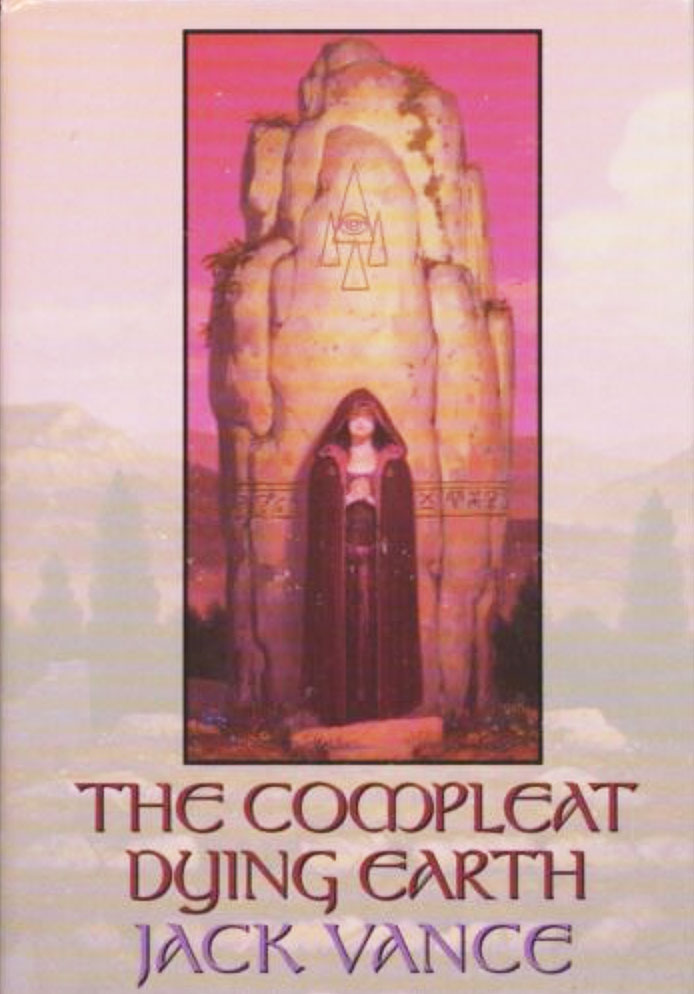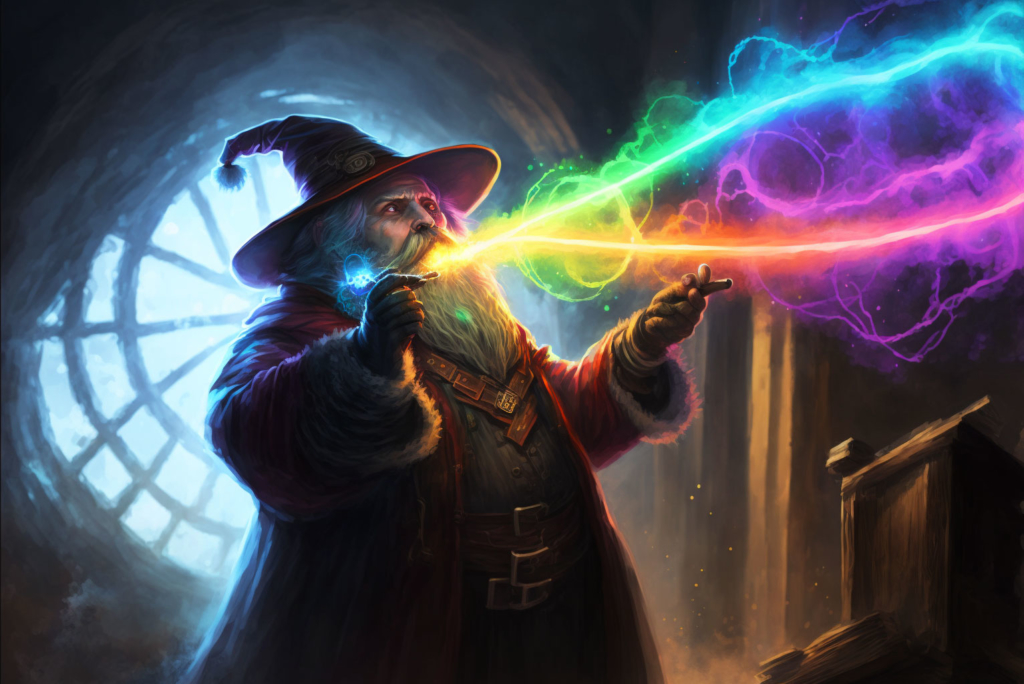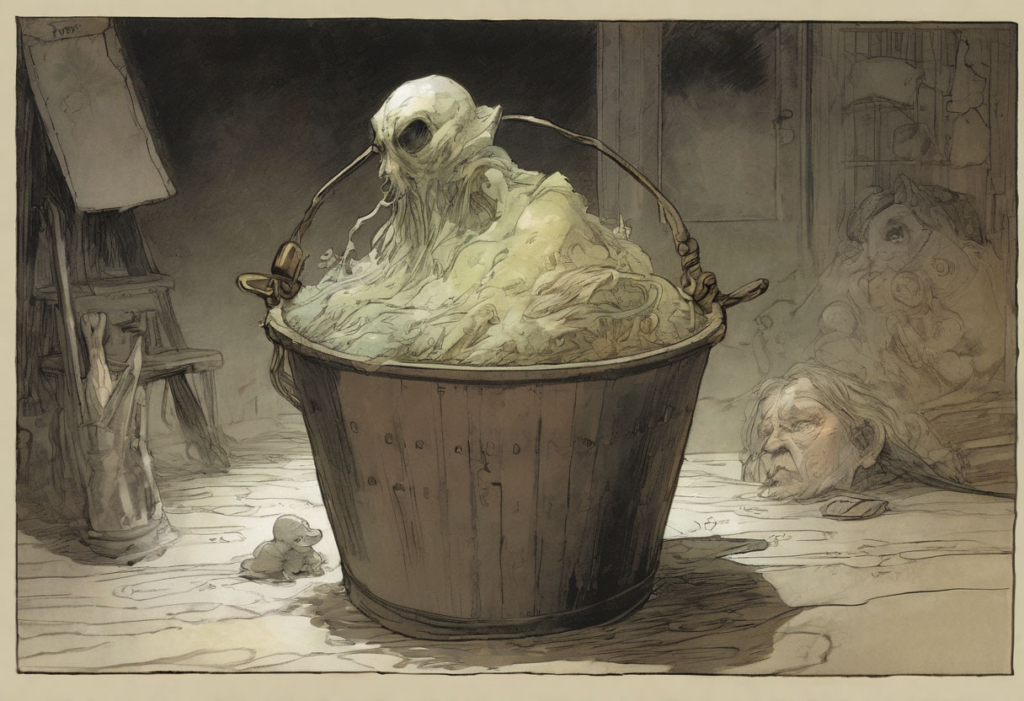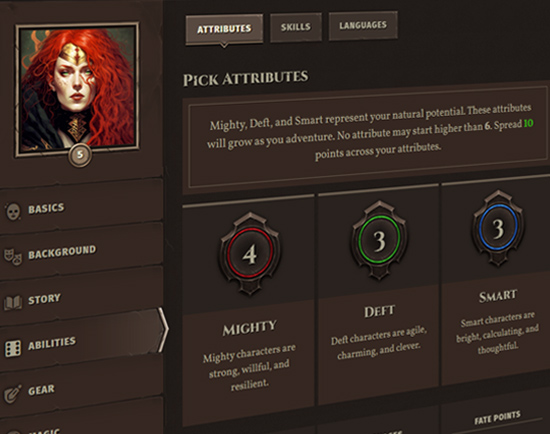When designing the rules for magic (how spells and magic items behave) I set myself some guidelines I would abide by religiously so as to avoid the pitfalls of previous systems. Here’s what I had in mind!
Figuring out a way for spells and magic items to work in OSR+ in a consistent and modular way was really important to me in the overall design of the system. As I've written elsewhere, I started roleplaying with Second Edition Dungeons & Dragons, which I admire for its wondrous and sprawling treatment of magic, but also hate for its wondrous and sprawling treatment of magic.
On Modularity in OSR+

Modularity is one of the most important aspects of design I wanted to adhere to in OSR+. I wanted to be able to create new content that could fit seamlessly into the system without me having to worry about power creep or how the new stuff would gel with existing classes, kits, or origins. I still have to worry about that, but not nearly as much as would be the case in other trad systems.
With magic, the problems I noticed in Second Edition and other trad games were twofold: verbosity and specificity. The wacky, longwinded Vancian origins of magic in D&D and all its knockoffs has only been exacerbated by the gamification of the hobby brought on by Wizards of the Coast. Spells can be as long as a page, specify weird spatial dimensions in their use, and have all sorts of annoying exceptions and prescriptions baked into their rules. The same is true of magic items. Both lose a sense of wonder when their principal use is to emit 5d6 fireballs once per day in a 200 foot radius, etc.
Indie games coming out of PbtA and the OSR traditions have been fantastic innovators when it comes to getting away from crunch and back to those wondrous fundamentals. My favorite books in this regard are Marvels & Malisons and Wonders & Wickedness from Lost Pages. I marveled at the simplicity and evocativeness of the language in these texts, and that inspired me to make that the standard among the spells in my own system.

Wonder, Not Utility
You'll notice in OSR+ that none of the spells in the system do damage. This is intentional, and inspired by the OSR texts I reference above. Doing damage with your magic is handled in the form of each spellcaster having a "maleficence" that lets the player shape what that looks like in any way they can imagine. Maleficence as a concept was lifted from Lost Pages. This is kind of like how some of the superheroes in X-Men who have elemental powers can do different things with them depending on the envirommental context in which they need to use them. For this reason, you won't see 16 versions of fireball in OSR+.



Instead, spells always allow the spellcaster to do something supernatural. Spells also generally do not provide purely mechanical bonuses, because mechanical bonuses are not wondrous. There are a few that do (take Enchant Weapon, for example), but even that spell was designed with the wondrous moment of its use in mind—take the scene in the TV version of Game of Thrones where Melisandre sets aflame the weapons of an army in the dark.
Like spells, treasures are designed in the same way. Few things, to me, are more boring than a +1 sword. Magic items should break the rules or provide new abilities to heroes, and so that's what I designed them to do.
Some Other Principles
I also wanted to avoid spells that instantly kill people. Not because it's brutal, but because it's neither creative, nor fun. In the same vein, spells that stun or otherwise incapacitate characters tend to last for a very short length of time in OSR+, or allow victims to continually resist them, that way they can get back into the action quickly. This is mostly to solve for the "not-being-fun" aspect of stunning abilities: there's nothing worse than simply not being able to play the game when you're playing the game.
Spell Logic
Central to the way spells work in OSR+ are their underlying logic.
Spell logic, you say? Yes, I do say!
While this logic is laid out in greater detail in the core rules, I want to walk through an example spell to demonstrate how spell logic works and makes things easier for everyone.
The point of developing a spell "logic" for OSR+ is so that players and the GM can fill in the gaps where the rules are silent, this way you don't have to reference anything other than the spell text to reason your way to a valid interpretation of how the spell might function in any given context. It also allows you to scale up any spell's effects in every dimension, without having to reference written parameters in the spell text.
Scaling Spells in OSR+
Since spells are infinitely scalable in every dimension, every spell becomes more powerful the more powerful you become.
Take the spell Vanish, for example:
You'll notice Vanish's text doesn't specify any parameters like duration, area of effect, targets, costs, and so forth, but from the base spell logic we know all spells have just three parameters:
duration
If a spell has a duration, it lasts a number of rounds equal to your level, plus 1 round per MP spent to cast the spell. For example, if you are 3rd level and spend 2 MP to cast a spell, it will last 5 rounds.
Targets
If the spell has targets, it can affect a number of targets in its area of effect equal to the MP spent to cast the spell.
Area of Effect
For 1 MP, the spell has a personal area of effect (unless it says otherwise). For 2 MP, the spell's area of effect is a melee space; for 3 MP, an encounter space. Each additional 3 MP adds another encounter space.
So we know from these assumptions that if I'm a 1st level spellcaster spending 1 MP:
- The spell can last up to 2 rounds (my level, plus the 1 MP I spent)
- I can make one object disappear (1 MP per target)
- The area in which I can make my targets disappear is a personal space (1 MP = personal space).
Now if I had put more MP into the spell at the time of casting, every parameter of the spell scales up. Suppose the scene of the encounter were a large thieves guild warehouse. The size of an encounter space would be the whole warehouse. So if I spent 3 MP, my spell becomes more powerful:
- The spell can last up to 4 rounds (my level, plus the 3 MP I spent)
- I can make up to four objects of any size disappear, so long as they are smaller than the encounter space (1 MP per target, plus the spell's unique restrictions on the target's size)
- The area in which I can make my targets disappear is the whole encounter space (3 MP = the encounter space).
By having this base spell logic underlying every spell, it becomes a matter of looking for exceptions to the baseline assumptions in that logic, when reading the spell's text. In the spell Vanish, the unique exception is that "the size of the object is limited to the area of effect," but we know the area of effect is a function of how much MP we put into the spell.

Doing Cool Shit at Level 1
Trad systems often lock the coolest spells behind higher levels you'll likely never reach because you just won't play the campaign long enough to get there. I've always wanted to cast Time Stop, for example, but in Dungeons & Dragons, that spell was end-game magic. I didn't want this to be the case in OSR+, so there are no spell levels in the system: every spell is available to any type of spellcaster at character creation. At the same time, I was also careful to write spells in such a way that they can be scaled up, so that more powerful wizards could do crazier things given that they would have more MP at their disposal.
Magic Items
Magic items were also written in a similarly simplistic fashion and each one takes no more than a paragraph to describe. This is because magic items rely on a concept of magical strength and rarity to determines their utility. When a magic item is found, you roll a d6 to determine its magical strength, whereas each magic item has a specific rarity value.
- Strength is a mechanical indication of its power, and determines the number of times the item can be used per day (or the number of uses it has if it's consumable), and how long its effects last, if not otherwise indicated.
- Rarity, like magical strength, ranges from 1 to 6 and indicates how unique the magic item is in the game world, and also is a hint at how powerful are the abilities it grants. The higher the rarity, the more priceless a magic item is.
For example, an Amulet of Soul Preservation has a rarity of 6, because the unique ability it confers to its wearer is pretty freakin powerful. Its magical strength is irrelevant, since it provides a couple passive abilities that are always in effect:
Amulet of Soul Preservation
As long as you wear this amulet, you are immune to any magic that would attempt to take control of your body. Moreover, if you are slain while wearing the amulet, your soul will be preserved within it until the amulet is destroyed (thereby freeing your soul to pass on), or another person dons the amulet, in which case they must make an opposed Smart check to resist your possessing their body.
On the other hand, a Bag of Bones has a rarity of 2, because not only is it consumable, but its effects are temporary. The value you roll for magical strength when you discover the bag would determine how many bones it contains:
Bag of Bones
The unassuming leather pouch contains 1 wishbones per strength of the item. When you remove a bone from the bag and crack it, the bone transforms into a skeleton warrior under your command. The warrior serves for 1 hour, then perishes.
Closing Thoughts
Hopefully here I've shed some light on the reason why spells and treasure are written the way they are in OSR+, in the absence of a (forthcoming) game master's guide! I've always been a fan of purposeful gaps, because they often open the door for clever players to invent uses of magic I'd never considered before.
Just ask my players about Phantom Bucket or Rainbow Bridge, and they will have some memorable stories to tell you.
 Archetypes
Archetypes Armor
Armor Classes
Classes Conflicts
Conflicts Cultures
Cultures Ethos
Ethos Flaws
Flaws Glossary
Glossary Kits
Kits Maleficence
Maleficence Origins
Origins Shields
Shields Skills
Skills Spells
Spells Stances
Stances Status Effects
Status Effects Tactics
Tactics Talents
Talents Techniques
Techniques Treasure
Treasure Weapons
Weapons











 Hall of Heroes
Hall of Heroes Hall of Legends
Hall of Legends



 Dungeons & Flagons
Dungeons & Flagons
0 Comments on
Designing for Magic in OSR+